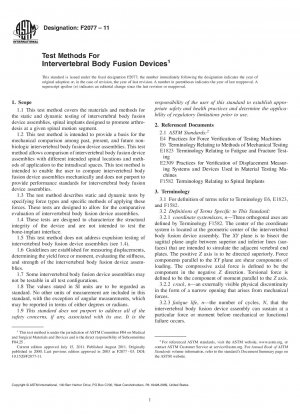ASTM F2077-11
Test Methods For Intervertebral Body Fusion Devices
- Standard No.
- ASTM F2077-11
- Release Date
- 2011
- Published By
- American Society for Testing and Materials (ASTM)
- Status
- Replace By
- ASTM F2077-14
- Latest
- ASTM F2077-22
- Scope
Intervertebral body fusion device assemblies are generally simple geometric-shaped devices which are often porous or hollow in nature. Their function is to support the anterior column of the spine to facilitate arthrodesis of the motion segment. This test method outlines materials and methods for the characterization and evaluation of the mechanical performance of different intervertebral body fusion device assemblies so that comparisons can be made between different designs.
This test method is designed to quantify the static and dynamic characteristics of different designs of intervertebral body fusion device assemblies. These tests are conducted in vitro to allow for analysis and comparison of the mechanical performance of intervertebral body fusion device assemblies to specific force modalities.
The forces applied to the intervertebral body fusion assemblies may differ from the complex loading seen in vivo, and therefore, the results from these tests may not directly predict in vivo performance. The results, however, can be used to compare mechanical performance of different intervertebral body fusion device assemblies.
Since the environment may affect the dynamic performance of intervertebral body fusion device assemblies, dynamic testing in a saline environment may be considered. Fatigue tests should first be conducted in air (at ambient temperature) for comparison purposes since the environmental effects could be significant. If a simulated in vivo environment is desired, the investigator should consider testing in a saline environmental bath at 37°C (for example, 0.9-g NaCl per 100-mL water) at a rate of 1 Hz or less. A simulated body fluid, a saline drip or mist, distilled water, or other type of lubrication at 37°C could also be used with adequate justification.
If the devices are known to be temperature and environment dependent, testing should be conducted in physiologic solution as described in 5.4. Devices that require physiologic solution for testing should be tested in the same type solution for comparison purposes.
The location within the simulated vertebral bodies and position of the intervertebral body fusion device assembly with respect to the loading axis will be dependent upon the design, the manufacturer’s recommendation, or the surgeon’s preferred method for implant placement.
It is well known that the failure of materials is dependent upon stress, test frequency, surface treatments, and environmental factors. Therefore, when determining the effect of changing one of these parameters (for example, frequency, material, or environment), all others must be kept constant to facilitate interpretation of the results.
1.1 This test method covers the materials and methods for the static and dynamic testing of intervertebral body fusion device assemblies, spinal implants designed to promote arthrodesis at a given spinal motion segment.
1.2 This test method is intended to provide a basis for the mechanical comparison among past, present, and future nonbiologic intervertebral body fusion device assemblies. This test method allows comparison of intervertebral body fusion device assemblies with different intended spinal locations and methods of application to the intradiscal spaces. This test method is intended to enable the user to compare intervertebral body fusion device assemblies mechanically and does not purport to provide performance standards for intervertebral body fusion device assemblies.
1.3 The test method describes static and dynamic tests by specifying force types and specific methods of applying these forces. These tests are......
ASTM F2077-11 Referenced Document
- ASTM E1823 Standard Terminology Relating to Fatigue and Fracture Testing
- ASTM E2309 Standard Practices for Verification of Displacement Measuring Systems and Devices Used in Material Testing Machines
- ASTM E4 Standard Practices for Force Verification of Testing Machines
- ASTM E6 Standard Terminology Relating to Methods of Mechanical Testing
- ASTM F1582 Standard Terminology Relating to Spinal Implants
ASTM F2077-11 history
- 2022 ASTM F2077-22 Standard Test Methods for Intervertebral Body Fusion Devices
- 2018 ASTM F2077-18 Test Methods For Intervertebral Body Fusion Devices
- 2017 ASTM F2077-17 Test Methods For Intervertebral Body Fusion Devices
- 2014 ASTM F2077-14 Test Methods For Intervertebral Body Fusion Devices
- 2011 ASTM F2077-11 Test Methods For Intervertebral Body Fusion Devices
- 2003 ASTM F2077-03 Test Methods For Intervertebral Body Fusion Devices
- 2001 ASTM F2077-01 Test Methods For Intervertebral Body Fusion Devices
- 2000 ASTM F2077-00 Test Methods For Intervertebral Body Fusion Devices
